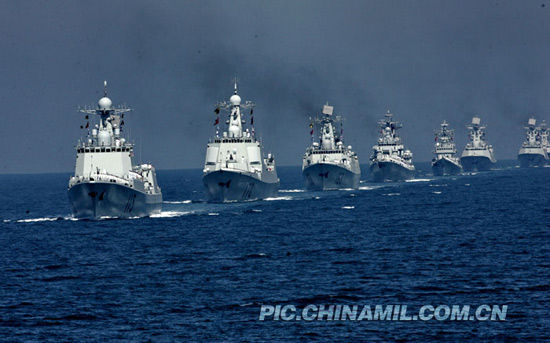By Mark Valencia
December 8, 2011
Nautilus invites your contributions to this forum, including any responses to this article.
——————–
CONTENTS
III. Nautilus invites your responses
I. Introduction
Mark Valencia, Nautilus Institute Associate and NARP Research Associate, explores options for the upcoming ASEAN and China negotiations concerning a Code of Conduct (CoC) to govern activities in the South China Sea. There are hopes that a Code can be presented and approved at the ASEAN-China 2012 summit, but the key elements have yet to be decided. Valencia contends that the CoC must include an agreement as to 1) where, to whom, and to what the Code applies, 2) how it addresses non-state actors and Taiwan (which is a South China Sea claimant), and 3) the scope of the Code; it should govern all activities, including resource exploration and exploitation, marine scientific research, and military activities.
The views expressed in this article do not necessarily reflect the official policy or position of the Nautilus Institute. Readers should note that Nautilus seeks a diversity of views and opinions on significant topics in order to identify common ground.
-“A Code of Conduct for the South China Sea: What Should It Contain?”
by Mark Valencia
A rash of run-ins between China and rival claimants in disputed areas in the South China Sea has prompted a search for a conflict avoidance and management mechanism. In January 2012 ASEAN and China will begin negotiating a Code of Conduct (CoC) to govern activities in the area and there are hopes that it will be prepared, presented and approved at the ASEAN-China 2012 summit.
There is a lot riding on the success of the venture: ASEAN centrality in security paradigms for the region, ASEAN solidarity, and the tone and tenor of ASEAN-China relations. A South China Sea CoC would also relieve some pressure on both China and ASEAN from the US and diminish the opportunity for US-China political conflict. Of course the proof of the pudding will be in its observance and “enforcement.” First the parties have to negotiate a text that is both acceptable to all and effective—a rather tall order given the diversity of interests of the ten ASEAN members (only four are claimants) and those of China.
Ideally, what would such a code contain? Some suggestions can be gleaned from the earlier ASEAN-China Declaration on Conduct, various agreements to manage incidents at sea and dangerous military activities, and other similar sources. First, there has to be agreement on where, to whom, and to what the Code applies; should it cover all of the South China Sea and any actor therein, or just the “disputed areas” and the national claimants? How should it treat non-state actors and Taiwan (which is also a claimant)? To be comprehensive it should govern all activities, including resource exploration and exploitation, marine scientific research, and military activities. As a fundament the Code should reaffirm the parties’ commitment to the purposes and principles of the UN, the 1982 Law of the Sea, China’s five principles of peaceful co-existence, as well as their shared responsibility to interact on the basis of equality and mutual respect.
Right up front should be a clause stating that nothing in the Code prejudices any party’s sovereign rights or jurisdiction in its claimed territory, territorial sea, continental shelf, EEZ or its rights and responsibilities under the 1982 Law of the Sea (UNCLOS). It should reaffirm that the sea is to be used only for peaceful purposes and the resolution of disputes without the threat or use of force in accordance with international law, including the 1982 UNCLOS. It should also reaffirm freedom of navigation and overflight consonant with international law. The parties should also recommit to exercising self-restraint in the conduct of activities that might complicate or escalate disputes, including refraining from occupying presently uninhabited features. The parties should also agree to negotiate provisional arrangements of a practical nature to manage and share the resources and activities in disputed areas. The modalities, scope and locations of bilateral and multilateral co-operation should be agreed upon by the parties concerned prior to their actual implementation. The parties should agree to notify each other of any pending activities including military exercises in waters of interest to other parties (i.e., areas claimed by others). There is a clear need for a specific clause addressing the question of arrest and detention of fishing vessels and crew of fellow claimants. As part of the CoC the parties might even agree to negotiate voluntary guidelines regarding military activities in foreign EEZ—particularly active and intrusive intelligence gathering.
There are two provisions that are probably critical to the CoC’s effectiveness. The first is an agreement to be bound by the Code and to develop a mechanism to explore alleged violations thereof. It should have the robustness of a treaty even if it is not called one. The second is to encourage “outside” parties to adhere and accede to the CoC. A Secretariat—or a special office in the ASEAN Secretariat—might be helpful in implementing and publicizing the Code. Dispute settlement should be compulsory and might be referred to the existing 1976 Bali Treaty on Amity and Cooperation dispute settlement mechanism, the International Court of Justice or the Tribunal for the Law of the Sea.
If such a Code can be agreed upon by ASEAN and China, it will certainly bode well for the Sea, the region, and all concerned, and may serve as a model for other disputed areas like the East China Sea.
III. Nautilus invites your responses
The Northeast Asia Peace and Security Network invites your responses to this article. Please send responses to: bscott@nautilus.org. Responses will be considered for redistribution to the network only if they include the author’s name, affiliation, and explicit consent.



2 thoughts on “Policy Forum 11-41: A Code of Conduct for the South China Sea: What Should It Contain?”